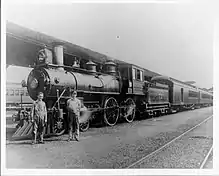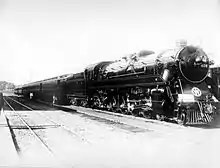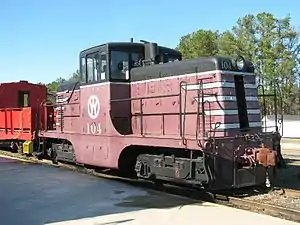New York, Ontario and Western Railway
The New York, Ontario and Western Railway, more commonly known as the O&W or NYO&W, was a regional railroad with origins in 1868, lasting until March 29, 1957 when it was ordered liquidated by a US bankruptcy judge. It was the first notable U.S. railroad with its mainline entirely abandoned.[1]
 | |
 A pocket calendar image of a New York, Ontario and Western Railway diesel locomotive built for freight service in 1947 | |
| Overview | |
|---|---|
| Headquarters | New York City, New York |
| Reporting mark | NYOW |
| Locale | North Jersey, Upstate New York and Northeastern Pennsylvania |
| Dates of operation | 1884–1957 |
| Technical | |
| Track gauge | 4 ft 8 1⁄2 in (1,435 mm) standard gauge |
| Length | 541 mi (871 km) |
New York, Ontario & Western | ||||||||||||||||||||||||||||||||||||||||||||||||||||||||||||||||||||||||||||||||||||||||||||||||||||||||||||||||||||||||||||||||||||||||||||||||||||||||||||||||||||||||||||||||||||||||||||||||||||||||||||||||||||||||||||||||||||||||||||||||||||||||||||||||||||||||||||
|---|---|---|---|---|---|---|---|---|---|---|---|---|---|---|---|---|---|---|---|---|---|---|---|---|---|---|---|---|---|---|---|---|---|---|---|---|---|---|---|---|---|---|---|---|---|---|---|---|---|---|---|---|---|---|---|---|---|---|---|---|---|---|---|---|---|---|---|---|---|---|---|---|---|---|---|---|---|---|---|---|---|---|---|---|---|---|---|---|---|---|---|---|---|---|---|---|---|---|---|---|---|---|---|---|---|---|---|---|---|---|---|---|---|---|---|---|---|---|---|---|---|---|---|---|---|---|---|---|---|---|---|---|---|---|---|---|---|---|---|---|---|---|---|---|---|---|---|---|---|---|---|---|---|---|---|---|---|---|---|---|---|---|---|---|---|---|---|---|---|---|---|---|---|---|---|---|---|---|---|---|---|---|---|---|---|---|---|---|---|---|---|---|---|---|---|---|---|---|---|---|---|---|---|---|---|---|---|---|---|---|---|---|---|---|---|---|---|---|---|---|---|---|---|---|---|---|---|---|---|---|---|---|---|---|---|---|---|---|---|---|---|---|---|---|---|---|---|---|---|---|---|---|---|---|---|---|---|---|---|---|---|---|---|---|---|---|---|---|
| ||||||||||||||||||||||||||||||||||||||||||||||||||||||||||||||||||||||||||||||||||||||||||||||||||||||||||||||||||||||||||||||||||||||||||||||||||||||||||||||||||||||||||||||||||||||||||||||||||||||||||||||||||||||||||||||||||||||||||||||||||||||||||||||||||||||||||||
The railroad began life as the New York and Oswego Midland Railroad, organized by Dewitt C. Littlejohn in 1868. Its mainline extended from Weehawken, New Jersey, in the greater New York City area to Oswego, New York, a port city on Lake Ontario. It had branch lines to Scranton, Pennsylvania; Kingston, New York; Port Jervis, New York; Monticello, New York; Delhi, New York; Utica, New York and Rome, New York. The part south of Cornwall, New York, was operated over the New York Central Railroad's West Shore Railroad via trackage rights.
History

.jpg.webp)
On September 3, 1869, the New York and Oswego Midland Railroad began using the Pennsylvania Railroad's station at Exchange Place which provided its passengers with ferry access to the Cortland Street Ferry Depot in lower Manhattan and the Desbrosses Street Ferry.[2]
In 1880, the O&W inherited the Oswego-New York corridor as well as the branches to Ellenville, Delhi and New Berlin, New York, from the New York & Oswego Midland, which had constructed the lines. The O&W improved the line by providing a new route to the New York City area from Middletown, NY which extended to Cornwall on the Hudson River and then to Weehawken Terminal. This development was made possible by negotiating rights of way from the New York, West Shore & Buffalo Railway,[3] later part of the New York Central system.
In 1886, the O&W acquired the operations of both the Utica, Clinton & Binghamton and the Rome & Clinton railroads from the Delaware & Hudson Canal Company. By acquisition of these assets and construction of a new line to Sylvan Beach on the east shore of Lake Oneida, the O&W extended its operations into new market areas, and the Sylvan Beach Loop became a seasonally-significant corridor by providing transportation to central New York's recreational resort area. By 1889, the O&W added two new branches, New Berlin to Edmeston, and Port Jervis to Monticello, connecting to the main line at Summitville, New York.
The most significant addition occurred in 1890, when the O&W constructed a 54-mile branch from Cadosia, New York, to Scranton, Pennsylvania, through the rich anthracite coal reserves in Pennsylvania's Lackawanna Valley. Revenues from this Scranton division strengthened O&W's revenues and provided the means for future improvements to the railroad. The railroad's W-in-O logo first appeared in 1892[4]
| Year | Traffic |
|---|---|
| 1925 | 688 |
| 1933 | 830 |
| 1944 | 957 |
| 1956 | 353 |


During the ill-fated "Morganization" of the New York, New Haven and Hartford Railroad (NH), the railroad acquired control of the O&W and installed NH president Charles Sanger Mellen as president for a year. Regulatory difficulties frustrated Mellen's plans to barter the O&W to the New York Central Railroad for concessions elsewhere.
The 1940s saw a receding of passenger service. In the early years of the 1940s, the Summitville-Kingston branch was reduced to a Sundays and holidays, summers only service.[5] Improved highways ended the O&W's passenger service to the resort areas of the lower Catskill Mountains (the "Borscht Belt") and lightly populated portions of Upstate New York, with the last train from Walton, New York, to Weehawken operating during the summer of 1948. The O&W's Walton-Delhi branch, all in Delaware County, was also eliminated in this period.[6] The last passenger train (from Roscoe, New York, to Weehawken Terminal) operated on September 10, 1953.[7]
Bankruptcy
The O&W began bankruptcy proceedings, from which it would never emerge, as early as 1937. Apart from total dieselization by 1948, it became antiquated. (It was known to locals as the "Old & Weary", "Old & Wobbly" or "Old Woman.")[1] The decrease of coal as a heating fuel for other than major power plants damaged its primary freight business, as did the end of rail transport of high-priority dairy products from Upstate New York to the Metro New York City area. The NH offered to purchase the company in 1952, but later withdrew its offer, citing its own financial problems.[8] Abandonment was loudly protested by towns along the line, which considered unpaid back taxes as an investment in the railroad. The New York state legislature approved a $1 million aid bill, citing the O&W as essential for civil defense, but the state civil defense commission rejected it.[8]
The federal government eventually recommended complete liquidation, which occurred on March 29, 1957. All O&W assets were auctioned. The diesel locomotives found new owners, but most of the rest was scrapped.[8] Certain sections of track serving shippers, many of which were industrial factories, were transferred by the bankruptcy court to other railroads allowing continued rail access by the plants. The Delaware, Lackawanna and Western Railroad received track from Utica to New Hartford, New York, and track in Norwich, New York, and Scranton, Pennsylvania. The New York Central took over sections of O&W New York track between Fulton and Oswego, as well track in Rome, Oneida, and Kingston. The transfers were approved before operations ceased at midnight on the 29th, and the transfer of other sections to the Erie Railroad was expected to be approved later.[9] A section of the track in New Hartford was still in operation in 2018 by the Northern Division of the New York, Susquehanna and Western Railway.
Legacy

By virtue of its superb online scenery and anachronistic operations, the O&W retains "cult status" among railroad and history buffs more than 50 years after its abandonment, with periodic bus tours of remaining railroad artifacts. New York State Route 17 parallels the O&W from south of Liberty to Hancock in Sullivan and Delaware counties.
Rail historian George Drury later commented that the O&W "had always been sickly and should not have been built" at just "541 miles".[8]
Parts of the Summitville - Kingston division,[10] ending at Kingston, have become a rail trail. Some of the stations have been converted into residences, including the Alligerville station in High Falls, New York, owned by Gerry Leonard since 2001 and used as a recording studio.[11]
The "Flying Diesel Corps"
On September 27, 1955, a 50-car O&W train in Hamilton, New York, traveling on a mainline approached a switch set for a siding which led to a coal trestle. Although the engineer fully applied the brakes, the train continued up the siding at more than 30 miles per hour (48 km/h) and through the trestle. It was learned that the 213-ton EMD FT diesel locomotive at the head of the train "flew" a distance of 150 feet (46 m) beyond the coal trestle from an elevation of 15 feet (4.6 m); total time of "flight" was later estimated to be between six and seven seconds. Two of the crew were seriously injured, but no crewmen were killed in the wreck.
An investigation by New York state police as to why the switch had been thrown resulted in no arrests. A dinner was later given in honor of the crew who each received a plaque proclaiming them to be members of the O&W's new "Flying Diesel Corps." Each plaque was topped with a cast presentation model of their F-unit locomotive; the castings were provided by EMD.
One of the freight cars involved in the accident was loaded with chocolate bars from the Nestlé plant in nearby Fulton, New York. It was said that when the younger residents of Hamilton learned of the spilled candy, they raced to collect what they could, and that as a result candy sales in the town were for some time afterward very low.[12]
See also
References
| Wikimedia Commons has media related to New York, Ontario and Western Railway. |
- kodtrak.railfan.net
- Railroad Ferries of the Hudson: And Stories of a Deckhand, by, Raymond J. Baxter, Arthur G. Adams, pg. 69 ,1999, Fordham University Press, 978-0823219544
- "Light On Railroad Methods.; Asking An Investigation Of The Old New-York And Oswego Midland" (PDF). The New York Times. May 13, 1882.
- Early 1890s O&W Annual Passes
- "New York, Ontario and Western Railway, Table 5". Official Guide of the Railways. National Railway Publication Company. 74 (1). June 1941.
- "New York, Ontario and Western Railway, Table 2 -freight only". Official Guide of the Railways. National Railway Publication Company. 82 (3). August 1949.
- American Rails, 'New York, Ontario and Western Railway' https://www.american-rails.com/nyow.html
- Drury, George H. (1994). The Historical Guide to North American Railroads: Histories, Figures, and Features of more than 160 Railroads Abandoned or Merged since 1930. Waukesha, Wisconsin: Kalmbach Publishing. pp. 91, 229–231. ISBN 0-89024-072-8.
- "Trackage is Assigned Lackawanna and N.Y. Central Named to Serve Shippers". New York Times. March 29, 1957. p. 33.
- "New York, Ontario and Western Railway, Table 1". Official Guide of the Railways. National Railway Publication Company. 64 (9). February 1932.
- "Legendary Rock Producer Lists His Converted Train Station in the Woods". Realtor.com. September 26, 2018 – via San Francisco Chronicle.
- O&W history at www.nyow.org